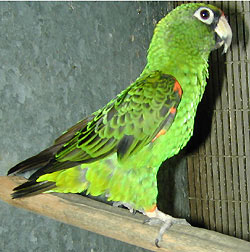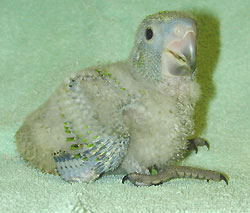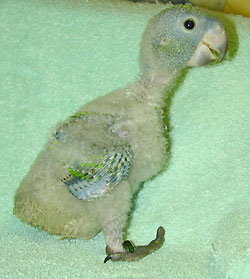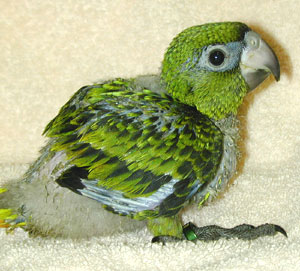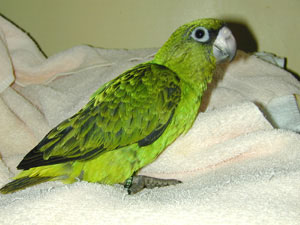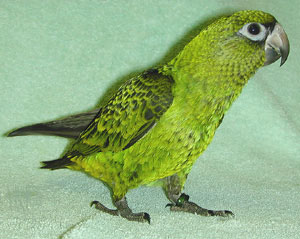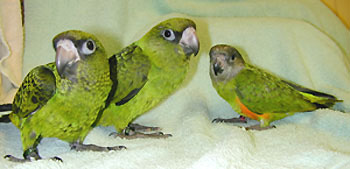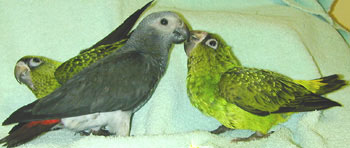Sorry, we no longer breed Jardine Parrots.
We have left up this page for informational purposes only.
Please go to our Main Page to see our current availabilities
and for more information, thank-you!

It has come to my attention that there is some confusion as to the subspecies of Jardine Parrots that we raise at Aves International. Following is an explanation of how we began breeding this wonderful specie and our explanation of common names vs. scientific names.
I first became enchanted with Jardine Parrots twenty-two years ago when I became acquainted with a neighbor who owned a pet wild-caught Lesser Jardine (Poicephalus gulielmi fantiensis). I soon purchased a pair of them to attempt breeding and begged the local Los Angeles importers to bring in more of these birds. Jardines were relatively rare in U.S. aviculture in those days and there wasn't much interest in them so the importers were reluctant to put much energy into getting them. Shipments from Africa came from West Africa in those days and Senegal Parrots, Jardines, and the smaller "West African or Ghana" African Greys were imported together. A year or so after seeing my first Jardine, the importers began bringing in the larger "Congo" African Greys from more southern areas of Africa- the Congo region. Eventually a few Jardines arrived in these shipments. These birds were clearly different from the other Jardines- larger, different shades of green, with a smaller area of darker orange coloring on the forehead. Some had more black coloring in the wings. We looked in Parrots of the World, by Forshaw and Cooper, and saw that these were larger subspecies that came from more southern areas of Africa. We called them "Congo Jardines". Sometimes only three or four birds would arrive in a shipment and, more often than not, they would be all males. I would patiently wait the months until the next shipment arrived and purchase the next few birds, again predominately males. Then finally I was fortunate to obtain females of these larger Jardines and immediately paired them with the lonely males. Nobody was sure exactly where in Africa these birds were caught and they were quite variable in appearance- different shades of green and orange, amount of black in the wings, and differences in size. I was not overly concerned about this and paired the birds as best I could. Remember, in those days there was very little prior avicultural interest in this species and very little published information about them. I was quite successful in breeding these and decided to work only with the "Congo Jardine" and sold my pair of Lesser Jardines. One time, several years later, I had three domestic females to pair and wanted new bloodlines. I purchased three wild-caught males form a quarantine station in Chicago. These three birds were even larger and darker than others I had seen previously. Their wings had more black coloration and the orange patch on the forehead was very dark orange. Their upper mandibles were quite pale. Upon inquiry, I was told that these were "Tanzanian"or "Black-Winged" Jardines. I looked in Forshaw's book and decided they were the subspecies "massaicus". They went into the breeding program paired with my females. These lovely birds have bred to the third and fourth generation in our collection and I am delighted to have had the opportunity to help establish them in American aviculture.
 they are all from the "larger" subspecies of Jardine
Parrots. I do not have "Lesser" Jardine bloodlines.
Although they vary as individuals (even within a clutch), the
general relative size of my Jardines in comparison to the smaller
Senegal, Red-Bellied, and Meyer's Parrots can be seen in this
photo. This bird in the photo is typical of my baby Jardines.
they are all from the "larger" subspecies of Jardine
Parrots. I do not have "Lesser" Jardine bloodlines.
Although they vary as individuals (even within a clutch), the
general relative size of my Jardines in comparison to the smaller
Senegal, Red-Bellied, and Meyer's Parrots can be seen in this
photo. This bird in the photo is typical of my baby Jardines.